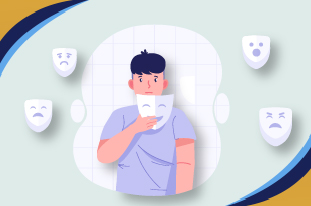The mask you wear is more than just feeling down.
Have you ever felt constantly pushing a boulder uphill, even when everything seems fine outwardly? You ace your work or professional life, maintain a good relationship, and even manage a smile. In all these scenarios, deep down in your inner self, there is a persistent dull ache, a feeling of not quite being there. This is not just a bad mood; it might be what psychologists refer to as “high-functioning depression,” a colloquial term for a persistent, milder form of depression known clinically as persistent depressive disorder (PDD), formerly known as dysthymia.
Clinical View of High-Functioning Depression
What is high-functioning depression? The term “high-functioning” is not a medical diagnosis. It is an explanation that highlights a critical aspect of PDD. Individuals can maintain daily responsibilities and appear to be coping well, even thriving, despite an underlying chronic low mood. This can make it extremely difficult for others, and even the people themselves, to admit that something is amiss.
According to the Diagnostic and Statistical Manual of Mental Disorders, Fifth Edition (DSM-5), PDD is marked by a depressed mood for most of the day, for more days than not, for at least two years. During these years, the person has never been without the symptoms for more than two months. While symptoms are less severe than major depressive disorder, their chronic nature can be just as weakening over time.
It can be better understood this way. Major depression is like a hurricane—intense, devastating, and undeniable. PDD, or high-functioning depression, is more like a persistent drizzle. It might not stop you from leaving the house, but it constantly depresses your spirits and makes you feel everything a bit heavier and less vibrant.
Read More: What is Endogenous Depression? Symptoms and Treatment
The Different Telltale Signs Beyond the Apparent
PDD often lacks the dramatic intensity of major depressive disorder; its symptoms can easily be forgotten or dismissed as personality traits, or “just how you are.” Here are some typical signs to look for.
- Persistent sadness or low mood: This is not always overt crying. It can show as a pervasive sense of emptiness, hopelessness, or a general lack of joy.
- Loss of interest or pleasure (anhedonia): Activities that once brought you joy now feel dull or uninteresting. You may go through the activities but feel little association.
- Exhaustion or low energy: Despite adequate rest, a feeling of being constantly tired.
- Changes in appetite or sleep habits: This could be sleeping too much or too little, or eating particularly more or less than normal.
- Low self-esteem: a feeling of inadequacy, self-criticism, and an idea that you are not “good enough.”
- Difficulty in concentration or making decisions: Even simple tasks can feel overwhelming, and your mind can feel foggy.
- Hopelessness: a sense that things would not get better, even if there are opportunities, or objectively they could.
- Irritability: For some, the persistent low mood can manifest as increased frustration or short-temperedness.
It is important to remember that these symptoms are persistent. They don’t just come and go with life’s changing; they are a consistent undercurrent.

Why Does This Happen?
While there are no evident causes of high-functioning depression, research points out a combination of genetic, biological, or environmental factors.
Read More: A Guide To Understand Smiling Depression
Neurobiology
Studies including the utilization of functional magnetic resonance imaging (fMRI) have indicated differences in brain activity and structure in individuals with depression. There might be imbalances in neurotransmitters like dopamine and norepinephrine, which help to regulate mood, sleep, appetite, and energy. They play a meaningful role in supporting the mood switch. Research published in journals like Biological Psychiatry highlights that altered neural circuits are involved in emotional regulation in individuals with chronic low mood.
Genetics
If you have a family history of depression, you can be more genetically disposed to have high-functioning depression signs. While it may not be a direct inheritance, the vulnerability can be passed down.
Life Experiences Or Stress:
Chronic stress, trauma, loss, or significant life changes can trigger or exacerbate high-functioning depression or PDD. The body’s prolonged stress response can impact neurochemical balance.
Personality Or Living Styles
Different personality traits, such as neuroticism or a tendency toward negative self-talk, can increase the possibility of PDD. Additionally, a maladaptive coping mechanism can perpetuate the cycle of low mood.
It is important to mention that PDD is not a character flaw or a sign of weakness. It is a medical condition with biological underpinnings, like diabetes or heart disease.
Read More: There’s Something About Disruptive Mood Dysregulation Disorder That You Should Know (DMDD)
Don’t “Just Tough It Out,” Find Psychiatric Help
The high-functioning element can be a double-edged sword. While it lets people continue their life tasks, it can also become the cause of delay or prevent them from receiving medical assistance. The typical practice that “if you can perform, you are fine” is damaging.
The person can have chances of increased risk of major depressive disorder, called “double depression.”
Their relationships can be affected by chronic low mood, which will lead to misunderstandings, withdrawal, or isolation.
Consistent chronic stress and depression can impact physical health while contributing to issues like weakened immune function, cardiovascular problems, and chronic pain.
Sometimes individuals can turn to the use of alcohol or drugs for self-medication, which further contributes to a low mood and further complications.

Effective Treatments
Although it seems disturbing to find high-functioning depression symptoms, the treatment is rather possible. A combination of therapeutic approaches usually gives the best results.
1. Psychotherapy (Talk Therapy)
Psychotherapy is usually the first step of treatment for PDD. It provides a safe edge to explore thoughts, feelings, and behaviors that add up to the persistent low mood.
Cognitive behavioral therapy CBT is positively useful for depression. It enables individuals to recognize and challenge negative thought practices and produce healthier coping strategies.
Next is interpersonal therapy, which focuses on enhancing interpersonal relationships and social functioning. It helps to identify the relationship issues that can often contribute to or aggravate depressive signs.
Psychodynamic therapy examines how past incidents and unconscious conflict can be the underlying reasons for recent moods and behavior.
Read More: Is Major Depressive Disorder The Same As Bipolar Disorder?
2. Medication
Sometimes, psychiatrists suggest antidepressants for treatment with ongoing therapies. Commonly prescribed medicines, Selective Serotonin Reuptake Inhibitors (SSRIs), are designed to help work with the increasing availability of serotonin in the brain. Doctors will determine if the medicine is suitable for the person’s health or not. Medical research consistently demonstrates the effectiveness of antidepressants in modulating neurotransmitter activity and alleviating depressive symptoms, typically when it is combined with psychotherapy.
3. Lifestyle Adjustments
While this is not an alternative to professional treatment for signs of high-functioning depression, integration of a healthy lifestyle with therapies can support recovery and well-being.
Regular Exercise: Physical activities have been shown to have antidepressant impacts by releasing endorphins and enhancing mood. You should set a target for at least 30 minutes of medium to extreme exercise within a week.
Balanced Nutrition: A diet rich in whole meals, fruits, vegetables, and lean proteins can help brain health and vitality levels.
Moderate sleep: At least take 7-9 hours of deep sleep for mood regulation and overall well-being.
Meditation: Practice meditation, like yoga, to become more aware of your ideas and feelings without judgment. It also helps foster a sense of calmness and present-moment awareness.
Read More: Coping Mechanisms For Depression: Practical Strategies To Help You Navigate
Adopt a Full of Energy Life
Feel like you are not alone in this condition. There are a considerable number of people like you in this world. Living with high-functioning depression or PDD is not normal, especially when people think you are ok, and there is a volcano continuously erupting in your mind. But millions of people are getting support and are having a normal life. The first step towards a solution is courage, and it is hard. But after that, it is likely to move from just”functioning” to truly growing.
Remember that seeking psychiatric help is a sign of resilience rather than weakness. Orange Coast Psychiatry professionals can provide a precise diagnosis and a custom approach that helps you break the persistent shadow of PDD and step into a life filled with more light and vitality.
We are here to find PDD, give you a clear understanding, and provide an evidence-based guide to understanding this often-misunderstood condition.
























